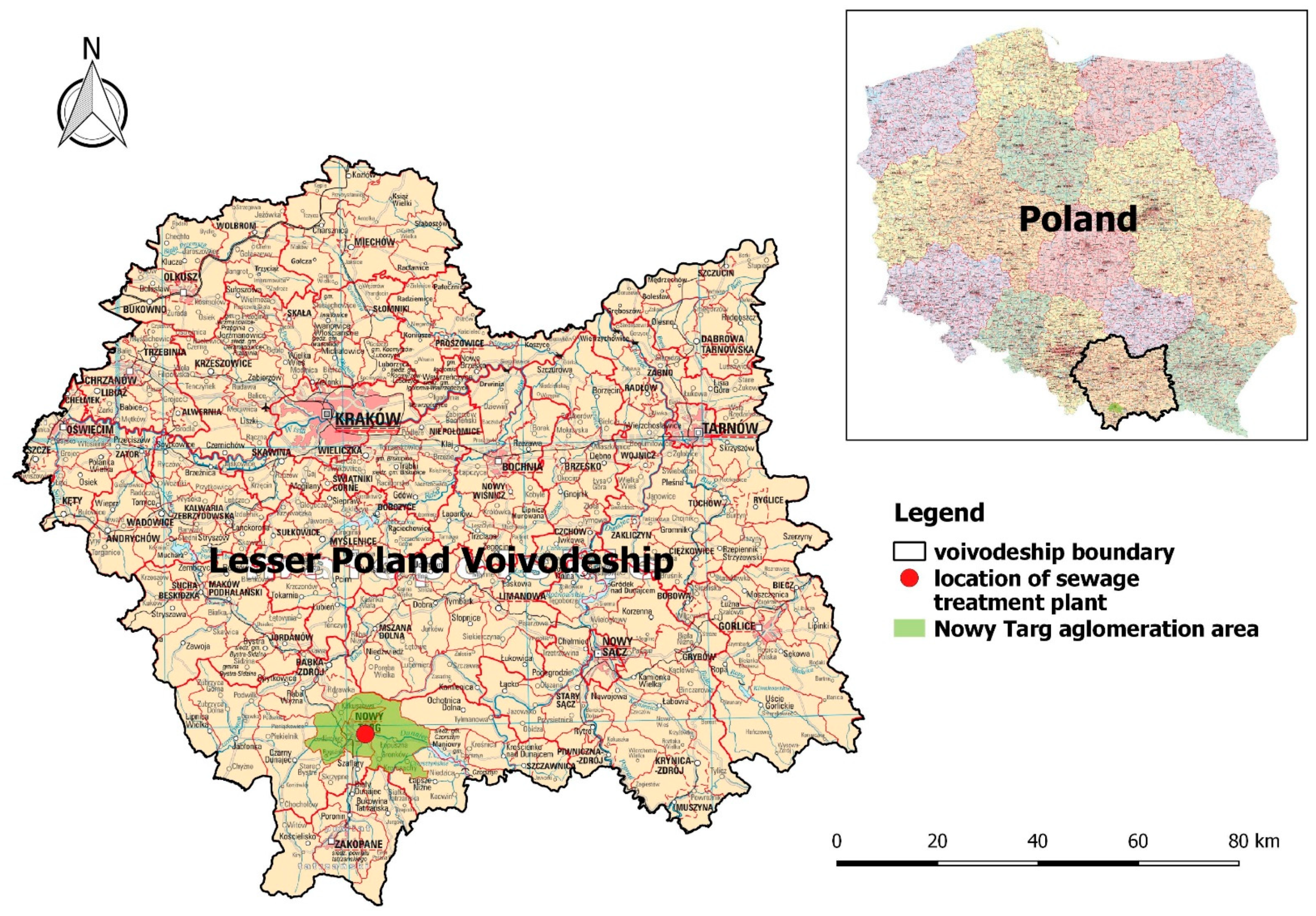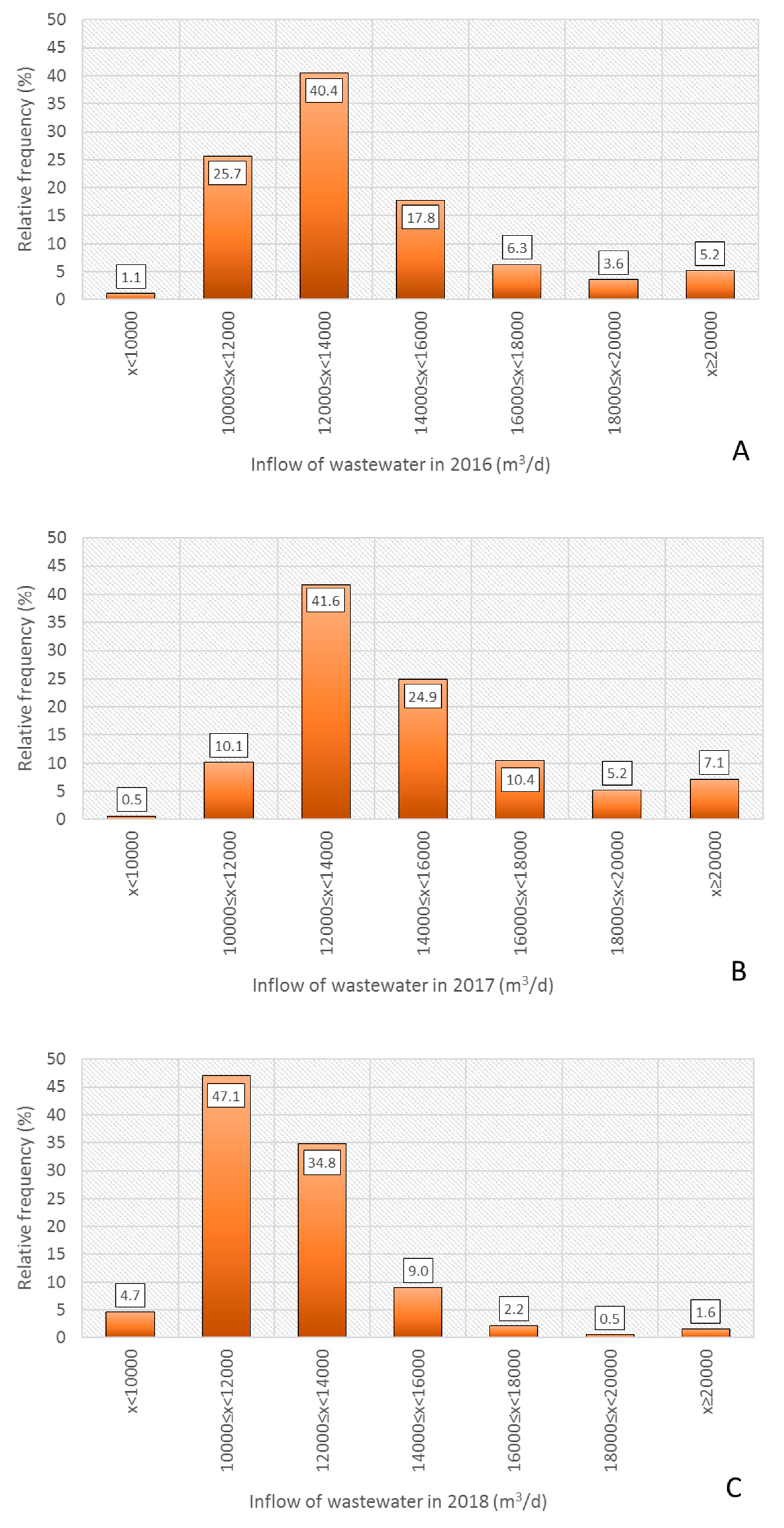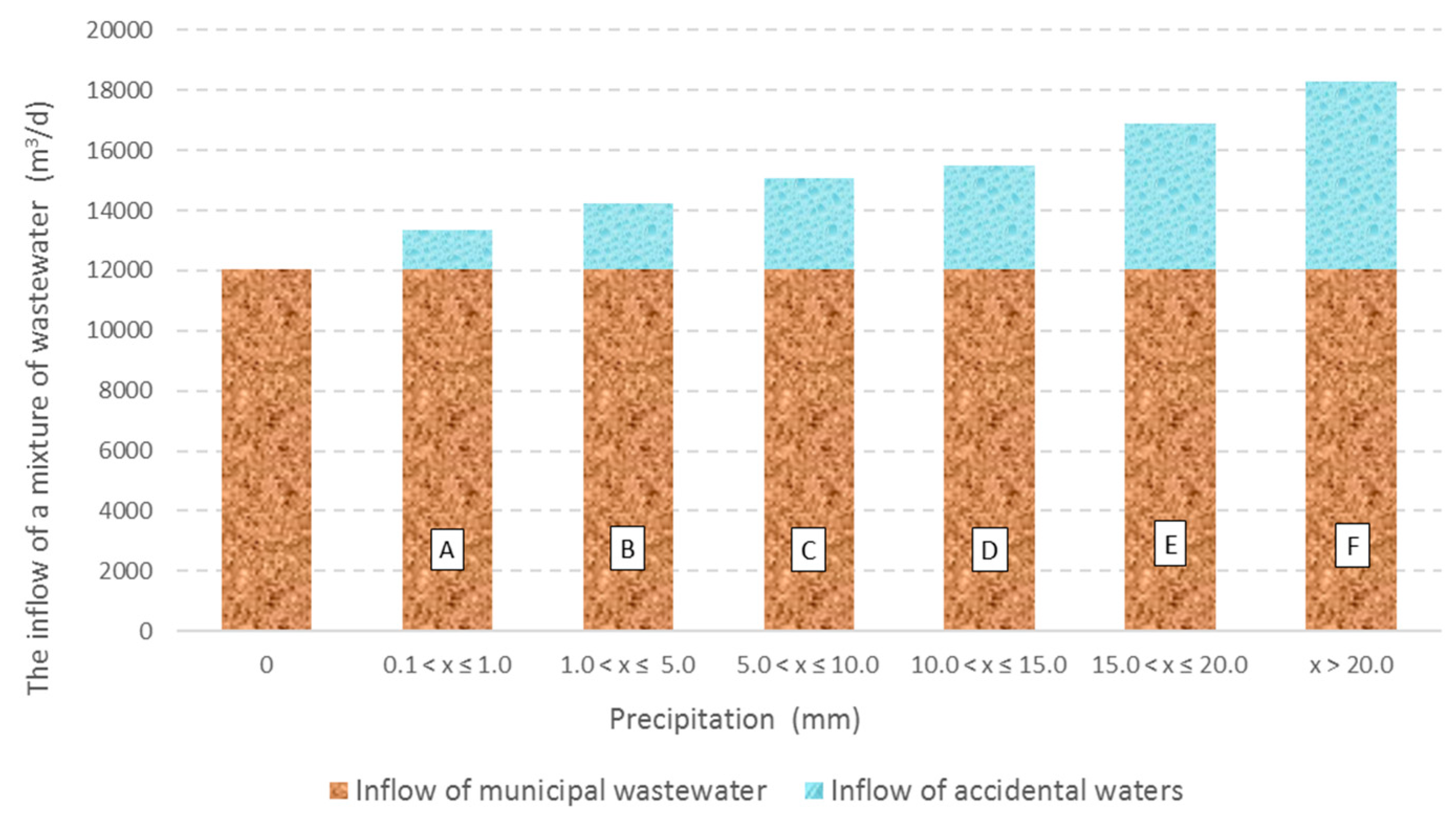The Impact of Atmospheric Precipitation on Wastewater Volume Flowing into the Wastewater Treatment Plant in Nowy Targ (Poland) in Terms of Treatment Costs
Abstract
:1. Introduction
2. Materials and Methods
2.1. Characteristics of the Sewage System and Wastewater Treatment Plant
2.2. Analytical and Statistical Methods
- A—0.1 to 1.0 mm/d,
- B—1.1 to 5.0 mm/d,
- C—5.1 to 10.0 mm/d,
- D—10.1 to 15.0 mm/d,
- E—15.1 to 20.0 mm/d,
- F—over 20.0 mm/d.
- Qdp—daily inflow of accidental water to the sewer, [m3/d];
- Qdm—daily inflow of the mixture of wastewater and accidental water during wet weather, (m3/d);
- Qds—average daily urban wastewater inflow (excluding accidental water) during dry weather, (m3/d).
- Uwp—daily contribution of accidental water to sewerage flowing out of sewer, (%);
- Qdp—daily inflow of accidental water to the sewer, (m3/d);
- Qdm—daily inflow into the sewerage system of the mixture of wastewater and accidental water during wet weather, (m3/d).
3. Results and Discussion
3.1. Analysis of Atmospheric Precipitation in the Sewage Catchment Area
3.2. Characteristics of the Inflow of Wastewater
3.3. Analysis of the Quantity of Accidental Water in the Sewerage System
3.4. Cost of Treatment and Discharge of Accidental Water
4. Conclusions
Author Contributions
Funding
Institutional Review Board Statement
Informed Consent Statement
Data Availability Statement
Conflicts of Interest
References
- Hynčica, M.; Huth, R. Long-term changes in precipitation phase in Europe in cold half year. Atmos. Res. 2019, 227, 79–88. [Google Scholar] [CrossRef]
- Młyński, D.; Cebulska, M.; Wałęga, A. Trends, Variability, and Seasonality of Maximum Annual Daily Precipitation in the Upper Vistula Basin, Poland. Atmosphere 2018, 9, 313. [Google Scholar] [CrossRef] [Green Version]
- Bugajski, P.; Kaczor, G.; Chmielowski, K. Variable dynamics of sewage supply to wastewater treatment plant depending on the amount of precipitation water inflowing to sewerage network. J. Water Land Dev. 2017, 33, 57–63. [Google Scholar] [CrossRef] [Green Version]
- Domínguez, I.; Ward, S.; Mendoza, J.-G.; Rincón, C.-I.; Oviedo-Ocaña, E.-R. End-User Cost-Benefit Prioritization for Selecting Rainwater Harvesting and Greywater Reuse in Social Housing. Water 2017, 9, 516. [Google Scholar] [CrossRef] [Green Version]
- Mańkowska-Wróbel, L. Basic problems of rainwater and meltwater management in urbanized areas. Pragmata Oikonomias 2014, 8, 209–2020. (In Polish) [Google Scholar]
- Marszelewski, W.; Piasecki, A. Analysis of the development of wastewater infrastructure in Poland in ecological and economical aspects. Eur. Policies Financ. Mark. 2014, 11, 127–137. [Google Scholar]
- Kaczor, G.; Bugajski, P. Impact of Snowmelt Inflow on Temperature of Sewage Discharged to Treatment Plants. Pol. J. Environ. Stud. 2012, 21, 381–386. [Google Scholar]
- Correa de Oliveira, D.-B.; Soares, W.-A.; Ribeiro de Holanda, M.-A. Effects of rainwater intrusion on an activated sludge sewer treatment system. Rev. Ambient. Água 2020, 15, 2497. [Google Scholar]
- Kaczor, G.; Bergel, T.; Bugajski, P. Impact of extraneous waters on the proportion of sewage pollution indicesregarding its biological treatment. Infra. Ecol. Rural Areas 2015, IV/3, 1251–1260. [Google Scholar]
- Wąsik, E.; Bugajski, P.; Chmielowski, K.; Cupak, A. The influence of precipitation in Sądecki basin on the variability of quantitative wastewater inflowing into the treatment plant Wielopole. Infra. Ecol. Rural Areas 2016, 2/II, 543–555. (In Polish) [Google Scholar]
- Kaczor, G.; Chmielowski, K.; Bugajski, P. The Effect of Total Annual Precipitation on the Volume of Accidental Water Entering Sanitary Sewage System. Rocz. Ochr. Sr. 2017, 19, 668–681. (In Polish) [Google Scholar]
- McMahan Erin, K. Impacts of Rainfall Events on Wastewater Treatment Processes. Graduate Theses and Dissertations, University of South Florida. 2006. Available online: http://scholarcommons.usf.edu/etd/3846 (accessed on 18 May 2021).
- Kaczor, G. Effect of infiltration and inflow waters on the performance of small sewer systems. Sci. Noteb. Agric. Univ. Krakow 2012, 495, 229. (In Polish) [Google Scholar]
- Bugajski, P.; Chmielowski, K.; Kaczor, G. Influence of rainwater inflow on the quality of sewage in a small sewage system. Acta Sci. Pol. Form. Circumiectus 2016, 15, 1–9. (In Polish) [Google Scholar]
- Kowalik, T.; Bogdał, A.; Borek, Ł.; Kogut, A. The effect of treated sewage outflow from a modernized sewage treatment plant on water quality of the Breń river. J. Ecol. Eng. 2015, 16, 96–102. [Google Scholar] [CrossRef]
- Bugajski, P.; Nowobilska–Majewska, E. A Weibull Analysis of the Reliability of a Wastewater Treatment Plant in Nowy Targ, Poland. Rocz. Ochr. Śr. 2019, 21, 825–840. [Google Scholar]
- Pawęska, K.; Duda, P. Impact of precipitation on the balance of wastewater treated in municipal wastewater treatment plant. Ecol. Eng. 2018, 19, 49–56. (In Polish) [Google Scholar] [CrossRef]
- Cottes, M.; Mainardis, M.; Goi, D.; Simeoni, P. Demand-Response Application in Wastewater Treatment Plants Using Compressed Air Storage System: A Modelling Approach. Energies 2020, 13, 4780. [Google Scholar] [CrossRef]
- Boruszko, D.; Miłaszewski, R.; Piotrowski, P. Evaluation of Economic Effectiveness of the Municipal Wastewater Treatment Plant in the Community of Sokoły. Rocz. Ochr. Śr. 2013, 15, 1086–1097. (In Polish) [Google Scholar]
- Remiszewska-Skwarek, A.; Fudala-Książek, S.; Łuczkiewicz, A. The Influence of Industrial Wastewater on the Energy Consumption and the Efficiency of Technological Processes in Municipal Wastewater Treatment Plant. Rocz. Ochr. Śr. 2016, 18, 110–121. (In Polish) [Google Scholar]
- Nowobilska–Majewska, E.; Bugajski, P. The Impact of Selected Parameters on the Condition of Activated Sludge in a Biologic Reactor in the Treatment Plant in Nowy Targ, Poland. Water 2020, 12, 2657. [Google Scholar] [CrossRef]
- Nowobilska-Majewska, E.; Bugajski, P. The determination of limit of tannery wastewater flowing to the wastewater treatment plant in Nowy Targ (Poland) in terms of the impact of chromium concentration on treated wastewater quality. Desalination Water Treat. 2021, 1–10, in press. [Google Scholar] [CrossRef]
- Chmielowski, K. Impact of atmospheric precipitation on the variability of wastewater discharge from a selected sewage system in Jaworzno. Acta Sci. Pol. Formatio Circumiectus 2019, 18, 39–49. [Google Scholar] [CrossRef]
- Pecher, R. Fremdwasseranfall im Kanalnetz—Ein wasserwirtschaftliches Problem? Korresp. Abwasser 1998, 45, 2250–2258. (In German) [Google Scholar]
- Cebulska, M.; Szczepanek, R.; Twardosz, R. Spatial Distribution of Precipitation in the Upper Vistula Basin. Average Annual Rainfall (1952–1981); W I S P K, I G i G P U J, Politechnika Krakowska im. T.; Kościuszki Wydział Inżynierii Środowiska: Kraków, Poland, 2013. (In Polish) [Google Scholar]
- Kaczorowska, Z. Opady w Polsce w przekroju wieloletnim. Przegląd Geogr. 1962, 33, 72. (In Polish) [Google Scholar]
- Młyński, D.; Chmielowski, K.; Młyńska, A. Analysis of hydraulic load of a wastewater treatment plant in Jasło. J. Water Land Dev. 2016, 28, 61–67. [Google Scholar] [CrossRef]
- Cieślak, O.; Pawełek, J. The inflow of foreign water to the sanitary sewage system on the example of the municipality of Mézos in France. Instal 2014, 7–8, 90–95. (In Polish) [Google Scholar]
- Butler, D.; Davies, J.W. Urban Drainage, 3rd ed.; Spon Press an Imprint; Taylor & Francis: London, UK; New York, NY, USA, 2011. [Google Scholar]
- Kaczor, G. Holes in the sewage canals’ hatches as one of the cause for the accidental water infiltration to the separate sewer system. Infra. Ecol. Rural Areas 2009, 9, 163–165. (In Polish) [Google Scholar]
- Wawrzynek, J. Methods of description and statistical inference. In Wydawnictwo Akademii Ekonomicznej im; Oskara Langego we Wrocławiu: Wrocław, Poland, 2007; Volume 37. (In Polish) [Google Scholar]
- Müller, T.; Schütze, M.; Bárdossy, A. Temporal asymmetry in precipitation time series and its influence on flow simulations in combined sewer systems. Adv. Water Resour. 2017, 107, 56–64. [Google Scholar] [CrossRef]
- Nowobilska–Majewska, E.; Bugajski, P. The Analysis of the Amount of Pollutants in Wastewater after Mechanical Treatment in the Aspect of their Susceptibility to Biodegradation in the Treatment Plant in Nowy Targ. J. Ecol. Eng. 2019, 20, 135–143. [Google Scholar] [CrossRef]
- Pajares, E.-M.; Valero, L.-G.; Sánchez, I. M-R. Cost of Urban Wastewater Treatment and Ecotaxes: Evidence from Municipalities in Southern Europe. Water 2019, 11, 423. [Google Scholar] [CrossRef] [Green Version]
- Matej-Łukowicz, K.; Wojciechowska, E. Fees for the discharge of stormwater. Res. Pap. Wrocław Univ. Econ. 2015, 411, 104–114. [Google Scholar]
- Królikowska, J.; Królikowski, A. Rainwater drainage fees—Needs and opportunities. Rocz. Ochr. Sr. 2013, 15, 1143–1152. (In Polish) [Google Scholar]
- Regulation of the Council of Ministers of December 22, 2017 on Unit Rates of Charges for Water Services. (Dz. U. z dnia 30 Grudnia 2017, poz. 2502)—Law Act. Available online: http://isap.sejm.gov.pl/isap.nsf/download.xsp/WDU20170002502/O/D20172502.pdf (accessed on 18 May 2021).
- Przybyła, C.; Bykowski, J.; Filipiak, J. Effectiveness of municipal wastewater treatment plants. Rocz. Ochr. Śr. 2009, 11, 231–239. (In Polish) [Google Scholar]






| Month | 2016 | 2017 | 2018 | 2019 |
|---|---|---|---|---|
| [mm] | ||||
| January | 44.1 | 19.9 | 7.0 | 96.6 |
| February | 82.2 | 35.9 | 8.8 | 35.2 |
| March | 28.6 | 42.4 | 17.3 | 39.4 |
| April | 54.3 | 106.5 | 20.8 | 68.1 |
| May | 93.6 | 51.6 | 47.0 | 154.9 |
| June | 24.2 | 90.7 | 110.5 | 41.9 |
| July | 132.9 | 85.9 | 96.7 | 107.4 |
| August | 86.9 | 106.0 | 53.2 | 83.0 |
| September | 64.8 | 227.8 | 43.6 | 61.6 |
| October | 127.1 | 124.9 | 46.1 | 41.4 |
| November | 68.1 | 61.0 | 13.3 | 55.6 |
| December | 85.9 | 64.0 | 68.1 | 79.1 |
| Total | 892.7 | 1016.6 | 532.4 | 864.2 |
| Parameters | Statistics | |||||
|---|---|---|---|---|---|---|
| Average m3/d | Median m3/d | Min. m3/d | Max. m3/d | Standard Deviation m3/d | Coefficient of Variation % | |
| Qa.d. | 12,046 | 11,824 | 8910 | 20,196 | 1609.8 | 13 |
Publisher’s Note: MDPI stays neutral with regard to jurisdictional claims in published maps and institutional affiliations. |
© 2021 by the authors. Licensee MDPI, Basel, Switzerland. This article is an open access article distributed under the terms and conditions of the Creative Commons Attribution (CC BY) license (https://creativecommons.org/licenses/by/4.0/).
Share and Cite
Bugajski, P.; Nowobilska-Majewska, E.; Majewski, M. The Impact of Atmospheric Precipitation on Wastewater Volume Flowing into the Wastewater Treatment Plant in Nowy Targ (Poland) in Terms of Treatment Costs. Energies 2021, 14, 3806. https://doi.org/10.3390/en14133806
Bugajski P, Nowobilska-Majewska E, Majewski M. The Impact of Atmospheric Precipitation on Wastewater Volume Flowing into the Wastewater Treatment Plant in Nowy Targ (Poland) in Terms of Treatment Costs. Energies. 2021; 14(13):3806. https://doi.org/10.3390/en14133806
Chicago/Turabian StyleBugajski, Piotr, Elwira Nowobilska-Majewska, and Michał Majewski. 2021. "The Impact of Atmospheric Precipitation on Wastewater Volume Flowing into the Wastewater Treatment Plant in Nowy Targ (Poland) in Terms of Treatment Costs" Energies 14, no. 13: 3806. https://doi.org/10.3390/en14133806
APA StyleBugajski, P., Nowobilska-Majewska, E., & Majewski, M. (2021). The Impact of Atmospheric Precipitation on Wastewater Volume Flowing into the Wastewater Treatment Plant in Nowy Targ (Poland) in Terms of Treatment Costs. Energies, 14(13), 3806. https://doi.org/10.3390/en14133806







